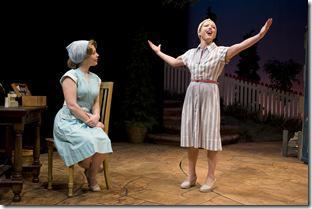
Ten Chimneys
Written by Jeffrey Hatcher
Directed by BJ Jones
North Shore Center for Performing Arts (map)
thru April 15 | tickets: $25-$60 | more info
Check for half-price tickets
Read entire review
A special slice of life and love

Northlight Theatre presents
Ten Chimneys
Review by Lawrence Bommer
Life and art, as well as love and work, were utterly indistinguishable for performing partners Alfred Lunt and Lynn Fontanne. These Broadway legends were the toast of Gotham, knew the high life of the Great White Way, and hob-nobbed with nabobs and notables at the top of the social pyramid. But for three months each year they left Glitter Gulch and retreated to the accurately named “Ten Chimneys,” Alfred’s 160-acre country estate in the wilds of Wisconsin, half way between Milwaukee and Madison. (It’s now become a major tourist attraction for southern Wisconsin, along with Frank Lloyd

In this rural enclave the dramatic duo would still receive visits for long weekends from the likes of professional pals Katharine Hepburn, Noel Coward, Laurence Olivier, and Helen Hayes. But it’s also where they brought a perfectionist discipline and painstaking precision to the plays they’d rehearse for the next touring season.
That’s the special slice of love and life that Jeffrey Hatcher affectionately depicts in a tribute as fulsome as any rave reviews that “the Lunts” ever received. Less a finished plot than a set of dramatized calling cards, Ten Chimneys delivers an intimate inside look at the private lives of America’s First Couple of the theater. BJ Jones’ sensitive staging at Northlight Theatre justifies the eavesdropping and becomes itself a salute to all the artful lies–personal, literary and communal–that actors spin into drama.
Hatcher presents Alfred and Lynne in 1938, 15 years into a marriage that will end when Alfred dies in 1977 and Lynn in 1983 at the age of 86. But now they’re at the height of their powers as they rehearse Chekhov’s The Seagull, starring the 19-year-old Uta Hagen as the doomed young actress Nina. Representing the summer entourage are Alfred’s gambling half-brother/chauffeur Carl and his housekeeper and half-sister Louise, as well as his magisterial mother Hattie (who as a proverbial “third wheel” is bored the rest of the year and makes up for it by controlling the summer). Representing the glamorous thespian world is redoubtable Sydney Greenstreet, here to play Counselor Sorin (and also to visit his ailing wife in a nursing home in Oconomowoc).
As the older Lunt amorously portrays the famous writer Trigorin who will destroy Nina’s happiness, it seems as if life imitates art. But Hatcher refuses to indulge in lazy parallels (and in fact Alfred has a very different lover staying in a hotel in Genesee Depot). Though his interest in the teenage Hagen is purely professional, that won’t stop Lynn from indulging in some operatic jealousy.
But it’s a summer storm that quickly blows over. Indeed, no personal crises are allowed to last long or take root in Ten Chimneys: They exist only as grist for the mill of theater. Here rehearsals can last twelve hours. Lateness, illness and hanky panky are forbidden. As Alfred says, “We need no drama in our house.” Work is love.
  
  |
Indeed, like Chekhov, nothing much happens. Revelations come in quiet moments, perhaps the best preparation for performing The Seagull possible. We see Lynn offer Uta the perfect makeup and lipstick for Nina’s changing conditions in the Chekhov play. We learn how the Lunts managed to create overlapping dialog without depriving the audience of necessary exposition. We hear how Lynn fell in love with Alfred’s reverse side as she first saw that he could act even with his back to the audience.
Only in a somewhat clumsy epilogue set after the war do we find out why Hagen had a very short run as Nina. With the fighting over, the Lunts can reopen Ten Chimneys and return to the business of theater. (Always performing together, their last show was The Visit in 1958 at the newly dedicated Lunt-Fontanne Theatre on Broadway.)
Suitably enough, Northlight’s offering exists for its acting, at once the most obvious and the most subtle homage that seven actors can offer their predecessors. (Making it real, however, is Tom Burch’s rustic set, whose turntable effortlessly takes us in and moves us out.) Lia Mortensen’s quicksilver Lynn is every inch acting royalty, always on stage and attuned to everything around her. V. Craig Heidenreich’s mannered Alfred adores his famous wife enough to curb his ego to her desires. His credo fits everything we see: Theater exists to depict “life as it is lived.”
Lance Baker brings irascible humor to the put-upon Carl, Janet Ulrich Brooks layers a thinly concealed frustration of Louise as a frustrated actress, and Linda Kimbrough is glacially passive-aggressive as an acerbic stage mother the exact opposite of Mama Rose (except for the inevitable predatory protectiveness). Steve Pringle brings a remarkable resemblance to the face, voice and form of roly-poly Greenstreet, an agreeable and self-effacing supporting actor in his pre-“Maltese Falcon” days. Finally, though perhaps a bit older than the role, Sara Griffin combines Uta and Nina in a dozen delicious ways.
We shall never more see the likes of the Lunts. But Ten Chimneys is happily haunted and well worth a pilgrimage by every theater lover and artist in Chicago.
Rating: ★★★
Ten Chimneys continues through April 15th at North Shore Center for the Performing Arts, 9501 Skokie Blvd. (map). Tickets are $25-$60, and are available by phone (847-673-6300) or online at Tickets.com (check for half-price tickets at Goldstar.com). More information at Northlight.org. (Running time: 2 hours 10 minutes, which includes an intermission)

All photos by Michael Brosilow

